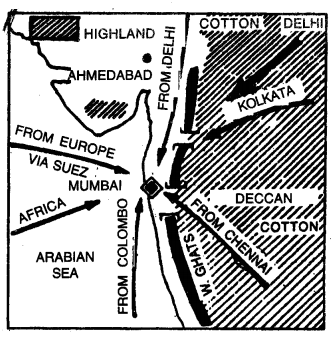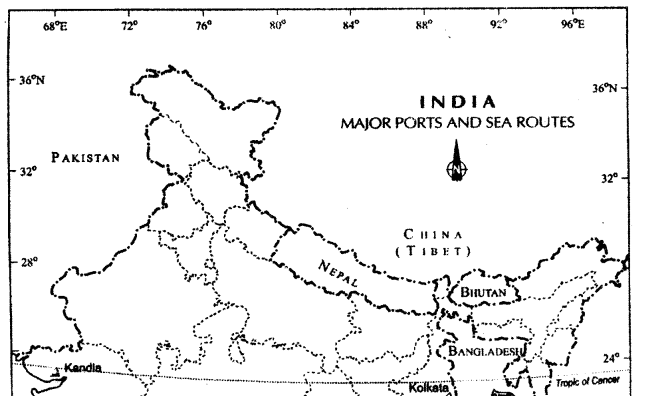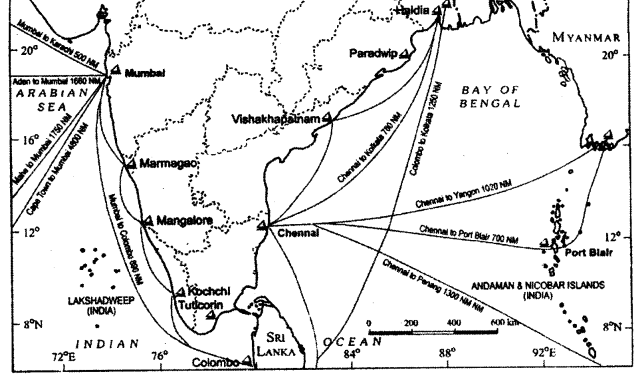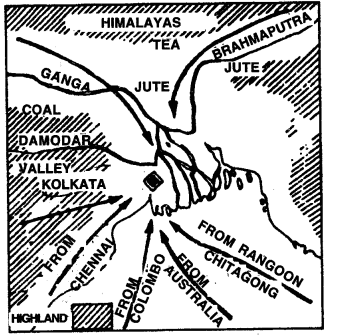Here we are providing Class 12 Geography Important Extra Questions and Answers Chapter 11 International Trade. Geography Class 12 Important Questions are the best resource for students which helps in class 12 board exams.
Class 12 Geography Chapter 11 Important Extra Questions International Trade
International Trade Important Extra Questions Very Short Answer Type
Question 1.
What was the value of foreign trade of India in 2010-11 ?
Answer:
₹ 28,74,600 crore.
Question 2.
What is the share of India in International trade ?
Answer:
1.1%.
Question 3.
Which port has been developed to relieve the pressure of Chennai port ?
Answer:
Ennore.
Question 4.
Name the import of India having the highest value ?
Answer:
Petroleum.
Question 5.
What is the value of adverse balance of trade in India in 2011 ?
Answer:
₹ 540,818 crore.
Question 6.
What in the value of total exports of India in 2011 ?
Answer:
₹ 1,142,649 crore.
Question 7.
To which Block, the most of exports go ?
Answer:
Asia-Oceania.
Question 8.
State the number of major ports of India ?
Answer:
12 major ports and 187 minor ports.
Question 9.
Name two new ports of India.
Answer:
Nhava Sheva and Paradip.
Question 10.
How many domestic airports are there in India ?
Answer:
11 international airports and 81 Domestic airports.
Question 11.
Name a new port of Tamil Nadu.
Answer:
Tuticorn.
Question 12.
State the difference between import- export trade of India.
Answer:
₹ 540,818 crore.
Question 13.
Name two main groups of imports of India.
Answer:
Fuel and Raw-material minerals.
Question 13 A.
Name the port developed on a Satellite port to relieve the pressure of Mumbai port.
Answer:
Nhava Sheva (Jawarher Lai Nehru Port).
Question 14.
What is the share of petroleum and petroleum products in India’s imports ?
Answer:
26 percent.
Question 15.
What is the share of minerals in exports of India ?
Answer:
5 percent.
Question 16.
To which eight countries of western Europe are exports from India sent ?
Answer:
Germany, U.K., Belgium, Italy, France, the Netherlands, Spain, Switzerland.
Question 17.
Which one of the Indian Sea Ports provides facilities to the land locked neigh- bouring countries ? Name any one such country. (C.B.S.E. 2009)
Answer:
Kolkata provides facilities to Nepal and Bhutan.
Question 18.
Name the oldest artificial sea port of India. (C.B.S.E. 2009)
Answer:
Chennai is the oldest artificial sea port of India. It was built in 1859.
Question 19.
Describe in brief any three measures that have been adopted by India to increase its share in the International trade. (C.B.S.E. 2009)
Answer:
India aims to double its share in the international trade within the next five years. The three measures have been adopted for it:
- Import liberalisation.
- Reduction in import duties
- Delicencing.
Question 20.
Name the first major sea port developed after Independence. (C.B.S.E. 2011, 2014)
Answer:
Kandla.
Question 21.
What is the meaning of the (C.B.S.E. 2013)
Answer:
An inland area adjoining the port which provides the resources of a port.
Question 22.
Name the major sea port I located on the Hoogly river. (C.B.S.E. 2013)
Answer:
Kolkata.
International Trade Important Extra Questions Short Answer Type
Question 1.
Mention four important items which India imports from other countries.
Answer:
- Petroleum and Petroleum products.
- Fertilisers
- Machinery
- Transport Equipment.
Question 2.
Name four important items which India exports to other countries.
Answer:
- Manufactured goods
- Readymade garments
- Cotton yarn
- Leather goods.
Question 3.
Name five countries of Africa with which India has trade relations.
Answer:
- South Africa
- Nigeria
- Kenya
- Ivory coast
- Tanzania.
Question 4.
Name the ports of India located on the East coast.
Answer:
Kolkata, Haldia, Vishakapatnam, Paradip, Chennai, Tuticorn.
Question 5.
State the major problem being faced by Kolkata Seaport. (CBSE 2018)
Answer:
Problem of silt accumulation in Hugli River which provides a link to the sea.
Question 6.
Give two reasons for the increase in difference between value of import and exports trade of India.
Answer:
In 2010-1 lvalue of imports was ₹ 1,683,467 croreand the value of exports was ₹ 1,142,649 crore and difference was ₹ 540,818 crore. Gap between import and export values has widened, resulting a mounting adverse balance of trade.
There are two major reasons for this state of affairs: first is the hike in prices on the world level and second is the declining value of Indian rupee in the world market. Slow growth in production, increasing domestic consumption and keen competition in the world market are other reasons of slow growth in export.
Question 7.
Name the items whose share in import of India has increased.
Answer:
Fertilisers, Chemicals, Machinery, Electrical and Non-electrical goods and Machinery.
Question 8.
Name the items whose share in imports of India has declined.
Answer:
Food products, Food grain, Pulses, Milk products, Fruit, Vegetables.
Question 9.
Name the agricultural products of export from India.
Answer:
Among agricultural produces, marine products including fish and fish products are at the top accounting for 3.1 per cent of the total value of export. Next in importance are cereals, tea, oil cake, cashew nuts, spices, fruits and vegetables, coffee and tobacco. A small quantity of raw cotton is also exported.
Question 10.
‘Ports are the Gateways tp I trade’. Discuss. (C.B.S.E. 2014) !
Answer:
The word ‘Port’ comes from the latin word ‘Porta’ which means gateway. Port is the gateway of a country as exports and imports are handled through them. Therefore, ports are called the gateways to trade.
Question 11.
‘Ports function as focal points for foreign trade’. Explain.
Answer:
Sea ports function as focal points for foreign trade of India. They act as collection centres of commodities from hinterland for further shipment to foreign destinations on one hand, and as receiving points of foreign consignments coming to India for distributing them in the interior part of the country.
Question 12.
State two main characteristics of sea ports of India. Name any two states which have two major ports.
Answer:
There are 12 major ports of India. These are the gateways for imports and exports of India. These serve as collection centres for commodities to be exported and for commodities coming to India for distribution. West Bengal has two major ports of Kolkata and Haldia. Tamil Nadu has two major ports of Chennai and Tuticorin.
Question 13.
What is the role of sea ports in the foreign trade of India? Write any three points in this regard.
Answer:
Sea ports function as focal points for foreign trade of India.
- Ports act as collection centres of commodities from hinterland for further shipment to foreign distinations.
- Ports act as receiving points of foreign consignment coming to India for distribution.
- Ports are the gateway for foreign trade as these handle exports and imports.
Question 14.
Why is Mumbai called a Unique port ? Explain three reasons.
Answer:
- Mumbai is the biggest port of India as regards exports and imports are handled.
- It is a natural port with deep waters and safe facilities for big ships.
- It is an important industrial and commercial centre of India.
Question 15.
Explain the increase of share of petroleum and petroleum products in India’s import trade.
Answer:
Largest positive change occurred in petroleum and petroleum product group, which gained 23.8 per cent points during 1960-61 and 2000-01. In 1960-61, these items accounted for only 6.2 per cent of total import value but it reached to 19.2 per cent in 1973-74 and 26% per cent in 2004-05.
This rapid growth was more due to the increasing prices and less due to increasing quantity. During 1974, oil producing and exporting countries raised the price of crude petroleum many times. Consequently, petroleum bill jumped very high.
Question 16.
The importance of manufactured goods and raw materials in India’s, import trade has reduced. Explain.
Answer:
Manufactured goods also lost their significance. Among them, jute textile, cotton textile, leather goods and iron and steel products are the major sufferers. Significant decline was registered in items of crude material group. In this group, the decline in crude rubber, wood, timber, textile fibres and ferrous minerals has been most striking. This was due to increasing domestic production of these products.
Question 17.
Describe in brief the changing nature of export items in the international trade of India.
Answer:
- India’s international trade is continuously increasing.
- The share of agricultural and allied products is decreasing.
- The import of Petroleum products is increasing.
- The exports of coffee, tea, spices is decreasing.
- The share of fresh fruits and sugar has increased in exports.
- The share of manufactured goods has increased in exports.
- The export of engineering goods has increased.
- Share of Gems-pearls and ornaments in exports has increased.
Question 18.
Distinguish between a major and a minor port.
Answer:
| Major Port | Minor Port |
| 1. A port which handles traffic of ten lakh metric tonnes every year is known as a major port.
2. These ports are handled by Port Trusts and the Central Govt. 3. These ports have all the facilities to handle international trade of the country. 4. There are ten major ports of India like as Pondicherry. |
1. A port which handles traffic less than ten lakh metric tonnes every year is a minor port.
2. These port as are managed by the Stale Govt. 3. These ports handle the regional and coastal trade of a country. 4. There are 145 minor working ports such Mumbai, Chennai, etc. |
Question 19.
Distinguish between imports and exports.
Answer:
No country is self-sufficient in all the commodities. When a country produces a commodity more than its needs, this commodity is sent to the deficit countries. It is called export. When a country produces a commodity less than its needs, it has to get the commodity from other countries. This is called import. For example, India exports tea but imports petroleum.
Question 20.
Compare the east and west coast harbour in respect of their site, hinterland and pattern of foreign trade.
Answer:
| West Coast Ports | East Coast Ports |
| Site. The major ports situated on Western coast of India are Cochin, Mangalore. Marmagao. Mumbai and Kandla. These ports are river ports and artificial ports. There is the problem of silting due to many problems during cyclones. | The major ports situated on the Eastern coast of India are Kolknta. Paradip. Vishakhapatnam. Chennai and Tuticorin. There are natural ports situated along indented coast-line. These are deep, deposition by rivers and tides. Ships well- protected harbours. These provide face shelter to ships during monsoons. |
| 2. Hinterland. These ports have densely populated rich hinter lands. Raw cotton is the main product of these areas. The western ghats are important for plant-ation crops like tea, coffee, rubber, etc. These ports export tea, coffee, iron ore and manganese. | These ports have hinterlands with rich natural resources. Minerals are the main products of these areas. Ganges plain and Damodar valley is known for sugarcane, jute, rice, coal, iron, manganese and mica. These ports export manufactured goods and minerals like iron from Vishakhapatnam and Paradip |
Question 21.
Define the term ‘trade.’ Describe the features of rural marketing centres and urban marketing centres. (Outside Delhi 2019)
Answer:
Trade: Trade is essentially buying and selling of items produced elsewhere. The trade services are intended for profits. All this work takes in towns and cities and are called trading centres.
(а) Rural marketing centres: These centres cater to nearby settlements. These are quasi urban centres. Here personal and professional services are not well developed. These form local collecting and distributing centres. Most of these have mandis and also retailing centres. These supply goods demanded by rural folk.
(b) Urban marketing centres: These provide urban services. These supply specialised goods and services. These sell manufactured goods. Markets for labour, housing and semi-finished goods are held. These provides services of eduction, teachers, lawyers, consultants, physicians, dentists and veterinary doctors.
International Trade Important Extra Questions Long Answer Type
Question 1.
Describe the location, characteristics and commercial importance of major ports of India.
Answer:
Ports are protected inlets on the coast providing shelter to ships. An ideal port should haye indented coast line, deep water, rich hinterland and good climate. India has a coastline of 7,517 km long. There are 12 major, 22 medium and 185 minor ports.
Ports on the Western Coast:
1. Kandla. It is located at the head of gulf of Kachchh. It is a tidal port and is expected to take the place of Karachi. It is a natural and safe harbour connected with a vast and rich hinterland of North West India. An offshore terminal has been built at Vadinar. It has the facilities of entrance of large ships. It is located on the Suez Canal route. Main items of imports include petroleum, chemicals, fertilisers and machinery. Its main exports are salt, sugar, cement and cotton goods.

(2) Mumbai. Mumbai occupies central position on the west coast of India. It stands on an island connected with the mainland. Mumbai has developed as a port for historical reasons. The British Colonial interests were the major forces for its development. It is the only natural deep-water harbour of India. It is a 20 km. long and 10 km. wide port. It is connected with Europe through Suez Canal.
It has rich productive hinterland of black cotton soil region. It is a spacious and safe port with natural facilities for the big ships. It has 54 docks and many warehouses. It is also known as the ‘Gateway of India’. It is an important industrial and commercial town of India.
Textiles, oil seeds, hides and skins and manganese are its major exports. The imports include machinery, petroleum, raw films, fertilisers, paper and medicines. A new mechanised port is being developed at Nhava Sheva. (Jawaharlal Nehru port), it is the largest container port in India.
(3) Mormugao. This port lies on the west coast in Goa on an estuary. It is a deep natural harbour. Its hinterland includes Goa, Maharashtra and Karnataka. It exports mainly iron ore, groundnut and manganese. The imports include machinery and manufactured goods. Konkan Railway has helped its development.
(4) New Mangalore. It lies in Karnataka to export iron ore, fertilisers coffee, tea, yarn, etc.
(5) Cochin. Cochin lies on the Malabar coast in Kerala. It is called the queen of the Arabian sea. It has a large sheltered back waters formed by lagoons. It is a safe, deep and natural harbour. It is located on the route to Australia and the far east. It is an important naval centre and a shipyard. The major exports include tea, coffee, cashew nuts, rubber, pepper, cardamoms and cotton goods. The imports include oil, fertilisers, machinery and coal.


(B) Ports on the Eastern Coast:
(6) Kolkata. It is a river port on the mouth of Hugh about 120 kms. inland. It has a rich hinterland of productive agricultural Ganges-Brahmputra delta and Chhottanagpur region rich in minerals. It is located on the route to Japan and U.S.A. Ships have to depend upon tides to enter this port.
It gets silted and needs constant dredging. A new port of Haldia is being developed to share the burdens of Kolkata. It is the second biggest port of India. Its main exports are jute, tea, sugar, iron ore, mica and coal. The imports consist of machinery, chemicals, rubber, paper, etc.
(7) Vishakhapatnam. It is a new major port on the east coast of India. It lies mid-way between Kolkata and Chennai. It is a well protected natural harbour enclosed by hard rocks of Dolphin nose. It is connected with a mining region of iron ore, coal and manganese. Its hinterland includes Andhra Pradesh, Madhya Pradesh and Odisha. It has the largest shipyard of India. It exports iron ore, manganese, oilseeds, mica and tobacco. The imports include rice, machinery and petroleum.
(8) Paradip. It is a new major port on the Odisha coast on Mahanadi Delta. It is a deep natural port. It provides facilities for the stay of big ships. It has a vast hinterland of Odisha-Chhatisgarh-Jharkand with minerals, forest products and agricultural resources. It exports iron ore to Japan and other minerals like chrome, manganese and mica. The imports include fertilisers, chemicals and rice.
(9) Chennai. It is an artificial, man-made port on the east coast. It is the third largest port of India.

Two concrete walls (Break waters) have been built to provide shelter. Its hinterland includes Tamil Nadu and Karnataka. It is a rich agricultural region. The principal exports include tea, coffee, oilseeds, hides and skins, rubber, cotton goods and tobacco. The imports include, coal, rice, paper, chemicals and machinery.
(10) Ennore. It lies 25 km. North of Chennai.
(11) Tuticorn. It is a major port and lies South of Chennai.
Question 2.
Describe the main features of India’s Foreign trade.
Answer:
India’s Foreign Trade.
In ancient period, India had a large foreign trade. India was called the ‘Golden sparrow’. During the British Period, India became a market for the manufactured goods from Europe. The agricultural raw materials were exported to Britain. After Independence, India’s foreign trade has undergone many changes. It has the following characteristics
- Coastal Trade. Above 90% trade of India is by sea.
- Low Foreign Trade. The total amount of trade is very low. It is only 1% of the international trade of the world.
- Low per-capita Trade. Due to large population, the per capita trade in India is low as compared to other countries.
- Increase in Volume and Value of Trade. India’s trade is rising in volume as well as value.
| Year | Imports 7 crores | Exports ₹ crores | Total |
| 1950-51 | 608 | 608 | 1,214 |
| 1990-91 | 43,198 | 32,553 | 75.751 |
| 2000-2001 | 230.873 | 203,571 | 134.444 |
| 2010-2011 | 1,683,467 | 1,142.649 | 2,826,116 |
(v) Unfavourable Balance of Trade. Due to large import of machinery and petroleum, the balance of trade is becoming unfavourable.
| Year | Import ₹ crores | Export ₹ crores | Balance ₹ crores |
| 1990-91 | 43,193 | 32,553 | 10,645 |
| 2000-01 | 230.873 | 203,571 | 27.302 |
| 201.0-2011 | 1,683,467 | 1,142,649 | 540,818 |
(vi) Features of Export Trade—
(а) Traditional export. India still exports a large number of traditional goods like tea, jute-goods, cotton textile, oilseeds, minerals, hides and skins. Now, a large variety of goods are being exported.
(b) Manufactured goods and Engineering goods. India used to export mostly raw material, but now manufactured goods occupy a major share in the total exports. Their share has increased to 35%.
(c) A large number of buyers of exports. India has now trading links with a large number of countries. About 3000 items are exported every year.
(d) Change in direction of foreign trade. Great Britain was the biggest buyer of Indian goods. Our trade increased with U.S.A. and Russia during the last decade. Now, Japan is the biggest purchaser of Indian goods.
(vii) Features of import trade.
(a) Predominance of machinery. India is on the road to industrialisation. Machinery and transport- equipment form the major items of import.
(b) Increase in the transport of manufactured goods. The imports of manufactured goods is increasing. Paper, silk, chemicals and petroleum are being imported.
(c) Decrease in imports of food grains. Green Revolution has led to an increase in food production. Therefore, import of cotton, wheat, jute has decreased.
(d) Change in direction of foreign trade. U.S.A. has again emerged as the largest supplier of goods to India. Import trade has increased with Bangladesh, Japan, Russia, Iran and West Germany.
International Trade Important Extra Questions HOTS
Question 1.
‘India’s international trade has changed in recent years in terms of volume, composition and direction.’ Support the statement with examples. (C.B.S.E. 2009)
Answer:
Many changes have taken place in India’s foreign trade after 1947.
1. Volume of trade. The volume of trade has increased many times. In 1951, the total trade was ₹ 1,250 crore; but due to industrial development; it has risen to ₹ 28,26,116 crores in 2010-11.
2. Change in Composition of Exports. The import-export trade has undergone many changes. India used to export tea, jute, leather, iron ore, spices, etc. But now manufactured goods are exported such as Engineering goods, ready-made garments, Handicrafts, etc.
3. Changes in the Composition of Imports. The ratio of foodgrains, cotton, jute increased in import trade. But now petroleum, fertiliser, steel, industrial raw materials, machinery, chemicals, are mostly imported.
Question 2.
‘Most of India, foreign trade is carried through sea routes’. Explain the statement giving three reasons.
Or
Describe the importance of sea routes in handling India is foreign trade. (Delhi 2019)
Answer:
- India’s long coastline foster the development of ports.
- Indian ports are all weather ports having good harbour facilities.
- Most of India is foreign trade is carried through the sea routes.
- Sea routes act as receiving points of foreign consignment coming to India for distribution.